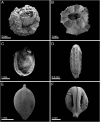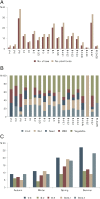The plant component of an Acheulian diet at Gesher Benot Ya'aqov, Israel
- PMID: 27930293
- PMCID: PMC5187744
- DOI: 10.1073/pnas.1607872113
The plant component of an Acheulian diet at Gesher Benot Ya'aqov, Israel
Abstract
Diet is central for understanding hominin evolution, adaptation, and environmental exploitation, but Paleolithic plant remains are scarce. A unique macrobotanical assemblage of 55 food plant taxa from the Acheulian site of Gesher Benot Ya'aqov, Israel includes seeds, fruits, nuts, vegetables, and plants producing underground storage organs. The food plant remains were part of a diet that also included aquatic and terrestrial fauna. This diverse assemblage, 780,000 y old, reflects a varied plant diet, staple plant foods, environmental knowledge, seasonality, and the use of fire in food processing. It provides insight into the wide spectrum of the diet of mid-Pleistocene hominins, enhancing our understanding of their adaptation from the perspective of subsistence. Our results shed light on hominin abilities to adjust to new environments, facilitating population diffusion and colonization beyond Africa. We reconstruct the major vegetal foodstuffs, while considering the possibility of some detoxification by fire. The site, located in the Levantine Corridor through which several hominin waves dispersed out of Africa, provides a unique opportunity to study mid-Pleistocene vegetal diet and is crucial for understanding subsistence aspects of hominin dispersal and the transition from an African-based to a Eurasian diet.
Keywords: Acheulian; food plants; paleo diet; seasonality; use of fire.
Conflict of interest statement
The authors declare no conflict of interest.
Figures




Similar articles
-
Systematic butchering of fallow deer (Dama) at the early middle Pleistocene Acheulian site of Gesher Benot Ya'aqov (Israel).J Hum Evol. 2008 Jan;54(1):134-49. doi: 10.1016/j.jhevol.2007.07.007. Epub 2007 Sep 14. J Hum Evol. 2008. PMID: 17868780
-
Nuts, nut cracking, and pitted stones at Gesher Benot Ya'aqov, Israel.Proc Natl Acad Sci U S A. 2002 Feb 19;99(4):2455-60. doi: 10.1073/pnas.032570499. Proc Natl Acad Sci U S A. 2002. PMID: 11854536 Free PMC article.
-
Pleistocene milestones on the out-of-Africa corridor at Gesher Benot Ya'aqov, israel.Science. 2000 Aug 11;289(5481):944-7. doi: 10.1126/science.289.5481.944. Science. 2000. PMID: 10937996
-
Possible paleohydrologic and paleoclimatic effects on hominin migration and occupation of the Levantine Middle Paleolithic.J Hum Evol. 2011 Apr;60(4):437-51. doi: 10.1016/j.jhevol.2010.03.010. Epub 2010 Jun 11. J Hum Evol. 2011. PMID: 20541789 Review.
-
Flaked stones and old bones: biological and cultural evolution at the dawn of technology.Am J Phys Anthropol. 2004;Suppl 39:118-64. doi: 10.1002/ajpa.20157. Am J Phys Anthropol. 2004. PMID: 15605391 Review.
Cited by
-
Ethnological approach to acorn utilization in prehistory: A case study of acorn mook making in South Korea.Front Plant Sci. 2022 Oct 18;13:996649. doi: 10.3389/fpls.2022.996649. eCollection 2022. Front Plant Sci. 2022. PMID: 36330271 Free PMC article.
-
Human Social Evolution: Self-Domestication or Self-Control?Front Psychol. 2020 Feb 14;11:134. doi: 10.3389/fpsyg.2020.00134. eCollection 2020. Front Psychol. 2020. PMID: 32116937 Free PMC article.
-
Evaluating the intensity of fire at the Acheulian site of Gesher Benot Ya'aqov-Spatial and thermoluminescence analyses.PLoS One. 2017 Nov 16;12(11):e0188091. doi: 10.1371/journal.pone.0188091. eCollection 2017. PLoS One. 2017. PMID: 29145432 Free PMC article.
-
Plant-related Philistine ritual practices at biblical Gath.Sci Rep. 2024 Feb 12;14(1):3513. doi: 10.1038/s41598-024-52974-9. Sci Rep. 2024. PMID: 38347005 Free PMC article.
-
A bioenergetic approach favors the preservation and protection of prey, not cooking, as the drivers of early fire.Front Nutr. 2025 May 16;12:1585182. doi: 10.3389/fnut.2025.1585182. eCollection 2025. Front Nutr. 2025. PMID: 40453719 Free PMC article.
References
-
- Ungar PS, Grine FE, Teaford MF. Diet in early Homo: A review of the evidence and a new model of adaptive versatility. Annu Rev Anthropol. 2006;35:209–228.
-
- Sponheimer M, Lee-Thorp JA. Isotopic evidence for the diet of an early hominid, Australopithecus africanus. Science. 1999;283(5400):368–370. - PubMed
-
- Sthal AB. Hominid dietary selection before fire. Curr Anthropol. 1984;25(2):151–168.
-
- O’Connel JF, Hawkes K, Jones NGB. Hadza scavenging: Implications for Plio-Pleistocene hominid subsistence. Curr Anthropol. 1988;29(2):356–363.
Publication types
MeSH terms
LinkOut - more resources
Full Text Sources
Other Literature Sources

